Approval Research for Carcinogen Humic-Like Substances (HULIS) Emitted from Residential Coal Combustion in High Lung Cancer Incidence Areas of China
Abstract
:1. Introduction
2. Materials and Methods
2.1. Sample Processing and Collection of Simulated Combustion Particulate Matter
2.2. Analytical Method of Water-Soluble Ionic Species and Water-Soluble Potentially Toxic Metals
2.3. Analytical Method of Organic Carbon (OC) and Elemental Carbon (EC)
2.4. Isolation and Measurement of Water-Soluble HULIS-C and WSOC
2.5. Assessment Method for Human Health Risk
2.6. Statistics
3. Results and Discussion
3.1. Mass Concentrations of RCC Particles
3.2. Size Distribution of Ion Species
3.3. The Characteristics of EC, OC, WSOC, and HULIS-C in RCC Particles
3.3.1. Abundance of EC, OC, WSOC, and HULIS-C in RCC Particles
3.3.2. Size Distribution of HULIS-C in RCC Particles
3.3.3. Correlation of HULIS-C and WSOC with Other Species in RCC Particles
4. Human Health Risk of WSPTMs via Inhalation Exposure
5. Conclusions and Perspectives
5.1. Conclusions
- (1)
- The particulate matters emitted from RCC were mainly distributed in the size range of <2.0 μm, which accounted for 52.45–77.16% of total particulate matter, which is higher than other areas of China.
- (2)
- HULIS-C to the PM was 2.09–5.65% for PM2.0 and 2.68–5.62% for PM2.0–7.0, respectively. HULIS-C emitted from RCC was mainly concentrated in PM2.0 (68.48–79.30%)
- (3)
- During our measurements, the concentrations of HULIS-C and WSOC were significantly correlated with SO42−, NO3−, and NH4+ in RCC particles.
- (4)
- HULIS-Cx to HULIS-Ct (%) values in RCC particles were 68.48–79.30% (average 73.95 ± 5.13%) for PM2.0 and 20.70–34.27 (average 26.05 ± 5.13%) for PM2.0–7.0, respectively. The HULIS-Cx to WSOCx (%) values in RCC particles were 32.73–63.76% (average 53.85 ± 12.12%) for PM2.0 and 33.91–82.67% (average 57.06 ± 17.32%) for PM2.0–7.0, respectively.
- (5)
- TCR values exceeded the acceptable level (1 × 10−6), indicating that we should pay more attention to these PTMs. For both children and adults, the CR of As was the highest followed by Cr (VI), and Pb had the lowest CR.
5.2. Perspectives
5.3. Policy Implications
- (a)
- The government should increase awareness of environmental protection in rural areas.
- (b)
- The government should improve the structure of houses and fireplaces in the area.
- (c)
- In order to effectively mitigate the severe PM2.5 pollution and promote environmental equity, a differentiated carbon policy should be considered. The local government should better adjust the structure of domestic energy, reduce the use of coal and biomass, and promote the use of environmentally friendly sources in Xuanwei area.
Supplementary Materials
Author Contributions
Funding
Institutional Review Board Statement
Informed Consent Statement
Acknowledgments
Conflicts of Interest
Abbreviations
| AT | Average lifetime |
| NH4+ | Ammonium ion |
| BL | Bole |
| CR | Carcinogenic risks |
| Ca2+ | Calcium ion |
| Cl− | Chlorine ion |
| CMAQ | Community Multiscale Air Quality |
| EC | Elemental carbon |
| US EPA | Environmental Protection Agency |
| ED | Exposure duration |
| EF | Exposure frequency |
| ET | Exposure time |
| HQ | Hazard quotient |
| HULIS | Humic-like substances |
| HULIS-C | HULIS containing carbon contents |
| GM | Guangming coal |
| LJW | Lijiawu coal |
| LM | Luomu |
| Mg2+ | Magnesium ion |
| NO3− | Nitrate ion |
| NO2− | Nitrite ion |
| IUR | Inhalation unit risk |
| RfC | Inhalation reference dose |
| OM | Organic Matter (OM) |
| K+ | Potassium ion |
| RCC | Residential coal combustion |
| ROS | Reactive oxygen species |
| HI | Total hazard quotient |
| TCR | Total carcinogenic risks |
| SIA | Secondary inorganic aerosol |
| SF | Shunfa coal |
| Na+ | Sodium ion |
| SO42− | Sulfate ion |
| WSOC | Water-soluble organic carbon |
| WSPTMs | Water-soluble potentially toxic metals |
| WSIIs | Water-soluble inorganic ions |
| ZF | Zongfan coal |
References
- Wang, W.; Shao, L.; Li, J.; Chang, L.; Zhang, D.; Zhang, C.; Jiang, J. Characteristics of individual particles emitted from an experimental burning chamber with coal from the lung cancer area of Xuanwei, China. Aerosol Air Qual. Res. 2019, 19, 355–363. [Google Scholar] [CrossRef]
- Mehra, D.; Geraghty, P.M.; Hardigan, A.A.; Foronjy, R. A Comparison of the Inflammatory and Proteolytic Effects of Dung Biomass and Cigarette Smoke Exposure in the Lung. PLoS ONE 2012, 7, e52889. [Google Scholar] [CrossRef] [PubMed]
- Dou, J.; Lin, P.; Kuang, B.Y.; Yu, J.Z. Reactive oxygen species production mediated by humic-like substances in atmospheric aerosols: Enhancement effects by pyridine, imidazole, and their derivatives. Environ. Sci. Technol. 2015, 49, 6457–6465. [Google Scholar] [CrossRef] [Green Version]
- Lin, P.; Yu, J.Z. Generation of reactive oxygen species mediated by Humic-like substances in atmospheric aerosols. Environ. Sci. Technol. 2011, 45, 10362–10368. [Google Scholar] [CrossRef] [PubMed]
- Sun, H.; Li, X.; Zhu, C.; Huo, Y.; Zhu, Z.; Wei, Y.; Yao, L.; Xiao, H.; Chen, J. Molecular composition and optical property of humic-like substances (HULIS) in winter-time PM2.5 in the rural area of North China Plain. Atmos. Environ. 2021, 252, 118316. [Google Scholar] [CrossRef]
- Tan, J.; Xiang, P.; Zhou, X.; Duan, J.; Ma, Y.; He, K.; Cheng, Y.; Yu, J.; Querol, X. Chemical characterization of humic-like substances (HULIS) in PM2.5 in Lanzhou, China. Sci. Total Environ. 2016, 573, 1481–1490. [Google Scholar] [CrossRef]
- Song, J.; He, L.; Peng, P.; Zhao, J.; Ma, S. Chemical and isotopic composition of humic-like substances (HULIS) in ambient aerosols in Guangzhou, South China. Aerosol Sci. Technol. 2012, 46, 533–546. [Google Scholar] [CrossRef]
- Zheng, G.; He, K.; Duan, F.; Cheng, Y.; Ma, Y. Measurement of humic-like substances in aerosols: A review. Environ. Pollut. 2013, 181, 301–314. [Google Scholar] [CrossRef] [PubMed]
- Fan, X.; Song, J.; Peng, P. Temporal variations of the abundance and optical properties of water soluble Humic-Like Substances (HULIS) in PM2.5 at Guangzhou, China. Atmos. Res. 2016, 172–173, 8–15. [Google Scholar] [CrossRef]
- Santos, P.S.M.; Santos, E.B.H.; Duarte, A.C. First spectroscopic study on the structural features of dissolved organic matter isolated from rainwater in different seasons. Sci. Total Environ. 2012, 426, 172–179. [Google Scholar] [CrossRef]
- Kristensen, T.B.; Prisle, N.L.; Bilde, M. Cloud droplet activation of mixed model HULIS and NaCl particles: Experimental results and κ-Köhler theory. Atmos. Res. 2014, 137, 167–175. [Google Scholar] [CrossRef]
- Birdwell, J.E.; Valsaraj, K.T. Characterization of dissolved organic matter in fogwater by excitation-emission matrix fluorescence spectroscopy. Atmos. Environ. 2010, 44, 3246–3253. [Google Scholar] [CrossRef]
- Lu, S.; Win, M.S.; Zeng, J.; Yao, C.; Zhao, M.; Xiu, G.; Lin, Y.; Xie, T.; Dai, Y.; Rao, L.; et al. A characterization of HULIS-C and the oxidative potential of HULIS and HULIS-Fe(II) mixture in PM2.5 during hazy and non-hazy days in Shanghai. Atmos. Environ. 2019, 219, 117058. [Google Scholar] [CrossRef]
- Xu, X.; Lu, X.; Li, X.; Liu, Y.; Wang, X.; Chen, H.; Chen, J.; Yang, X.; Fu, T.M.; Zhao, Q.; et al. ROS-generation potential of Humic-like substances (HULIS) in ambient PM2.5 in urban Shanghai: Association with HULIS concentration and light absorbance. Chemosphere 2020, 256, 127050. [Google Scholar] [CrossRef] [PubMed]
- Win, M.S.; Tian, Z.; Zhao, H.; Xiao, K.; Peng, J.; Shang, Y.; Wu, M.; Xiu, G.; Lu, S.; Yonemochi, S.; et al. Atmospheric HULIS and its ability to mediate the reactive oxygen species (ROS): A review. J. Environ. Sci. 2018, 71, 13–31. [Google Scholar] [CrossRef]
- Kuang, B.Y.; Lin, P.; Huang, X.H.H.; Yu, J.Z. Sources of humic-like substances in the Pearl River Delta, China: Positive matrix factorization analysis of PM2.5 major components and source markers. Atmos. Chem. Phys. 2015, 15, 1995–2008. [Google Scholar] [CrossRef] [Green Version]
- Ma, Y.; Cheng, Y.; Qiu, X.; Cao, G.; Fang, Y.; Wang, J.; Zhu, T.; Yu, J.; Hu, D. Sources and oxidative potential of water-soluble humic-like substances (HULISWS) in fine particulate matter (PM2.5) in Beijing. Atmos. Chem. Phys. 2018, 18, 5607–5617. [Google Scholar] [CrossRef] [Green Version]
- Srivastava, D.; Tomaz, S.; Favez, O.; Lanzafame, G.M.; Golly, B.; Besombes, J.L.; Alleman, L.Y.; Jaffrezo, J.L.; Jacob, V.; Perraudin, E.; et al. Speciation of organic fraction does matter for source apportionment. Part 1: A one-year campaign in Grenoble (France). Sci. Total Environ. 2018, 624, 1598–1611. [Google Scholar] [CrossRef]
- Moris, D.; Spartalis, M.; Spartalis, E.; Karachaliou, G.S.; Karaolanis, G.I.; Tsourouflis, G.; Tsilimigras, D.I.; Tzatzaki, E.; Theocharis, S. The role of reactive oxygen species in the pathophysiology of cardiovascular diseases and the clinical significance of myocardial redox. Ann. Transl. Med. 2017, 5, 326. [Google Scholar] [CrossRef] [Green Version]
- Li, R.; Liu, Y.; Wang, T.; Tang, J.; Xie, L.; Yao, Z.; Li, K.; Liao, Y.; Zhou, L.; Geng, Z.; et al. The characteristics of lung cancer in Xuanwei County: A review of differentially expressed genes and noncoding RNAs on cell proliferation and migration. Biomed. Pharmacother. 2019, 119, 109312. [Google Scholar] [CrossRef]
- Lui, K.H.; Bandowe, B.A.M.; Tian, L.; Chan, C.S.; Cao, J.J.; Ning, Z.; Lee, S.C.; Ho, K.F. Cancer risk from polycyclic aromatic compounds in fine particulate matter generated from household coal combustion in Xuanwei, China. Chemosphere 2017, 169, 660–668. [Google Scholar] [CrossRef]
- Finkelman, R.B.; Tian, L. The health impacts of coal use in China. Int. Geol. Rev. 2018, 60, 579–589. [Google Scholar] [CrossRef]
- Feng, X.; Shao, L.; Xi, C.; Jones, T.; Zhang, D.; BéruBé, K. Particle-induced oxidative damage by indoor size-segregated particulate matter from coal-burning homes in the Xuanwei lung cancer epidemic area, Yunnan Province, China. Chemosphere 2020, 256, 127058. [Google Scholar] [CrossRef] [PubMed]
- Zhang, M.; Shao, L.; Jones, T.; Hu, Y.; Adams, R.; BéruBé, K. Hemolysis of PM10 on RBCs in vitro: An indoor air study in a coal-burning lung cancer epidemic area. Geosci. Front. 2021. [Google Scholar] [CrossRef]
- Mumford, J.L.; He, X.Z.; Chapman, R.S.; Cao, S.R.; Harris, D.B.; Li, X.M.; Xian, Y.L.; Jiang, W.Z.; Xu, C.W.; Chuang, J.C.; et al. Lung cancer and indoor air pollution in Xuan Wei, China. Science 1987, 235, 217–220. [Google Scholar] [CrossRef]
- Li, G.; Yang, J.; Zhao, G.; Shen, Z.; Yang, K.; Tian, L.; Zhou, Q.; Chen, Y.; Huang, Y. Dysregulation of ferroptosis may involve in the development of non-small-cell lung cancer in Xuanwei area. J. Cell. Mol. Med. 2021, 25, 2872–2884. [Google Scholar] [CrossRef]
- Xiao, Y.; Shao, Y.; Yu, X.; Zhou, G. The epidemic status and risk factors of lung cancer in Xuanwei City, Yunnan Province, China. Front. Med. 2012, 6, 388–394. [Google Scholar] [CrossRef]
- Kim, C.; Chapman, R.S.; Hu, W.; He, X.; Hosgood, H.D.; Liu, L.Z.; Lai, H.; Chen, W.; Silverman, D.T.; Vermeulen, R.; et al. Smoky coal, tobacco smoking, and lung cancer risk in Xuanwei, China. Lung Cancer 2014, 84, 31–35. [Google Scholar] [CrossRef] [Green Version]
- Dai, S.; Tian, L.; Chou, C.L.; Zhou, Y.; Zhang, M.; Zhao, L.; Wang, J.; Yang, Z.; Cao, H.; Ren, D. Mineralogical and compositional characteristics of Late Permian coals from an area of high lung cancer rate in Xuan Wei, Yunnan, China: Occurrence and origin of quartz and chamosite. Int. J. Coal Geol. 2008, 76, 318–327. [Google Scholar] [CrossRef]
- Xiao, K.; Qin, A.; Wang, W.; Lu, S.; Wang, Q. Study on the characteristics of size-segregated particulate water-soluble inorganic ions and potentially toxic metals during wintertime in a high population residential area in Beijing, China. Processes 2021, 9, 552. [Google Scholar] [CrossRef]
- Win, M.S.; Zeng, J.; Yao, C.; Zhao, M.; Xiu, G.; Xie, T.; Rao, L.; Zhang, L.; Lu, H.; Liu, X.; et al. Sources of HULIS-C and its relationships with trace metals, ionic species in PM2.5 in suburban Shanghai during haze and non-haze days. J. Atmos. Chem. 2020, 77, 63–81. [Google Scholar] [CrossRef]
- Ding, X.; Qi, J.; Meng, X. Characteristics and sources of organic carbon in coastal and marine atmospheric particulates over East China. Atmos. Res. 2019, 228, 281–291. [Google Scholar] [CrossRef]
- Tian, J.; Ni, H.; Cao, J.; Han, Y.; Wang, Q.; Wang, X.; Chen, L.W.A.; Chow, J.C.; Watson, J.G.; Wei, C.; et al. Characteristics of carbonaceous particles from residential coal combustion and agricultural biomass burning in China. Atmos. Pollut. Res. 2017, 8, 521–527. [Google Scholar] [CrossRef]
- Zong, Z.; Chen, Y.; Tian, C.; Fang, Y.; Wang, X.; Huang, G.; Zhang, F.; Li, J.; Zhang, G. Radiocarbon-based impact assessment of open biomass burning on regional carbonaceous aerosols in North China. Sci. Total Environ. 2015, 518–519, 1–7. [Google Scholar] [CrossRef]
- Tan, J.; Duan, J.; Zhen, N.; He, K.; Hao, J. Chemical characteristics and source of size-fractionated atmospheric particle in haze episode in Beijing. Atmos. Res. 2016, 167, 24–33. [Google Scholar] [CrossRef]
- Fan, X.; Wei, S.; Zhu, M.; Song, J.; Peng, P. Comprehensive characterization of humic-like substances in smoke PM2.5 emitted from the combustion of biomass materials and fossil fuels. Atmos. Chem. Phys. 2016, 16, 13321–13340. [Google Scholar] [CrossRef] [Green Version]
- Wang, Y.; Hu, M.; Xu, N.; Qin, Y.; Wu, Z.; Zeng, L.; Huang, X.; He, L. Chemical composition and light absorption of carbonaceous aerosols emitted from crop residue burning: Influence of combustion efficiency. Atmos. Chem. Phys. Discuss. 2020, 20, 13721–13734. [Google Scholar] [CrossRef]
- Huo, Y.; Wang, Y.; Qi, W.; Jiang, M.; Li, M. Comprehensive characterizations of HULIS in fresh and secondary emissions of crop straw burning. Atmos. Environ. 2021, 248, 118220. [Google Scholar] [CrossRef]
- Xiang, P.; Zhou, X.; Duan, J.; Tan, J.; He, K.; Yuan, C.; Ma, Y.; Zhang, Y. Chemical characteristics of water-soluble organic compounds (WSOC) in PM2.5 in Beijing, China: 2011–2012. Atmos. Res. 2017, 183, 104–112. [Google Scholar] [CrossRef]
- Yang, Y.; Qin, J.; Qi, T.; Zhou, X.; Chen, R.; Tan, J.; Xiao, K.; Ji, D.; He, K.; Chen, X. Fluorescence characteristics of particulate water-soluble organic compounds emitted from coal-fired boilers. Atmos. Environ. 2020, 223, 117297. [Google Scholar] [CrossRef]
- Wang, W.; Zhang, W.; Dong, S.; Yonemachi, S.; Lu, S.; Wang, Q. Characterization, pollution sources, and health risk of ionic and elemental constituents in PM2.5 of wuhan, central China. Atmosphere 2020, 11, 760. [Google Scholar] [CrossRef]
- Men, C.; Liu, R.; Xu, F.; Wang, Q.; Guo, L.; Shen, Z. Pollution characteristics, risk assessment, and source apportionment of heavy metals in road dust in Beijing, China. Sci. Total Environ. 2018, 612, 138–147. [Google Scholar] [CrossRef] [PubMed]
- Xie, J.J.; Yuan, C.G.; Xie, J.; Niu, X.D.; He, A.E. PM2.5-bound potentially toxic elements (PTEs) fractions, bioavailability and health risks before and after coal limiting. Ecotoxicol. Environ. Saf. 2020, 192, 110249. [Google Scholar] [CrossRef] [PubMed]
- Liu, J.; Chen, Y.; Chao, S.; Cao, H.; Zhang, A.; Yang, Y. Emission control priority of PM2.5-bound heavy metals in different seasons: A comprehensive analysis from health risk perspective. Sci. Total Environ. 2018, 644, 20–30. [Google Scholar] [CrossRef] [PubMed]
- HosgoodIII, H.D.; Chapman, R.S.; He, X.; Hu, W.; Tian, L.; Liu, L.Z.; Lai, H.; Chen, W.; Rothman, N.; Lan, Q. History of lung disease and risk of lung cancer in a population with high household fuel combustion exposures in rural China. Lung Cancer 2013, 81, 343–346. [Google Scholar] [CrossRef] [PubMed] [Green Version]
- Barone-Adesi, F.; Chapman, R.S.; Silverman, D.T.; He, X.; Hu, W.; Vermeulen, R.; Ning, B.; Fraumeni, J.F.; Rothman, N.; Lan, Q. Risk of lung cancer associated with domestic use of coal in Xuanwei, China: Retrospective cohort study. BMJ 2012, 345. [Google Scholar] [CrossRef] [Green Version]
- Yan, Q.; Kong, S.; Yan, Y.; Liu, H.; Wang, W.; Chen, K.; Yin, Y.; Zheng, H.; Wu, J.; Yao, L.; et al. Emission and simulation of primary fine and submicron particles and water-soluble ions from domestic coal combustion in China. Atmos. Environ. 2020, 224, e5414. [Google Scholar] [CrossRef]
- Wang, S.; Wei, W.; Li, D.; Aunan, K.; Hao, J. Air pollutants in rural homes in Guizhou, China—Concentrations, speciation, and size distribution. Atmos. Environ. 2010, 44, 117308. [Google Scholar] [CrossRef]
- Zhou, J.; Xing, Z.; Deng, J.; Du, K. Characterizing and sourcing ambient PM2.5 over key emission regions in China I: Water-soluble ions and carbonaceous fractions. Atmos. Environ. 2016, 135, 20–30. [Google Scholar] [CrossRef]
- Dao, X.; Lin, Y.C.; Cao, F.; Di, S.Y.; Hong, Y.; Xing, G.; Li, J.J.; Fu, P.; Zhang, Y.L. Introduction to the national aerosol chemical composition monitoring network of China objectives, current status, and outlook. Bull. Am. Meteorol. Soc. 2019, 100, ES337–ES351. [Google Scholar] [CrossRef]
- Oros, D.R.; Simoneit, B.R.T. Identification and emission rates of molecular tracers in coal smoke particulate matter. Fuel 2000, 79, 515–536. [Google Scholar] [CrossRef]
- Zhang, H.; Wang, S.; Hao, J.; Wan, L.; Jiang, J.; Zhang, M.; Mestl, H.E.S.; Alnes, L.W.H.; Aunan, K.; Mellouki, A.W. Chemical and size characterization of particles emitted from the burning of coal and wood in rural households in Guizhou, China. Atmos. Environ. 2012, 51, 94–99. [Google Scholar] [CrossRef]
- Andreae, M.O.; Crutzen, P.J. Atmospheric aerosols: Biogeochemical sources and role in atmospheric chemistry. Science 1997, 276, 1052–1058. [Google Scholar] [CrossRef] [Green Version]
- Wen, J.; Shi, G.; Tian, Y.; Chen, G.; Liu, J.; Huang-Fu, Y.; Ivey, C.E.; Feng, Y. Source contributions to water-soluble organic carbon and water-insoluble organic carbon in PM2.5 during Spring Festival, heating and non-heating seasons. Ecotoxicol. Environ. Saf. 2018, 164, 172–180. [Google Scholar] [CrossRef]
- Li, X.; Han, J.; Hopke, P.K.; Hu, J.; Shu, Q.; Chang, Q.; Ying, Q. Quantifying primary and secondary humic-like substances in urban aerosol based on emission source characterization and a source-oriented air quality model. Atmos. Chem. Phys. 2019, 19, 2327–2341. [Google Scholar] [CrossRef] [Green Version]
- Qiao, T.; Zhao, M.; Xiu, G.; Yu, J. Seasonal variations of water soluble composition (WSOC, Hulis and WSIIs) in PM1 and its implications on haze pollution in urban Shanghai, China. Atmos. Environ. 2015, 123, 306–314. [Google Scholar] [CrossRef]
- Zhao, M.; Qiao, T.; Li, Y.; Tang, X.; Xiu, G.; Yu, J.Z. Temporal variations and source apportionment of Hulis-C in PM2.5 in urban Shanghai. Sci. Total Environ. 2016, 571, 18–26. [Google Scholar] [CrossRef] [PubMed]
- Li, M.; Fan, X.; Zhu, M.; Zou, C.; Song, J.; Wei, S.; Jia, W.; Peng, P. Abundance and Light Absorption Properties of Brown Carbon Emitted from Residential Coal Combustion in China. Environ. Sci. Technol. 2019, 53, 595–603. [Google Scholar] [CrossRef] [PubMed]
- Lin, P.; Huang, X.F.; He, L.Y.; Yu, J.Z. Abundance and size distribution of HULIS in ambient aerosols at a rural site in South China. J. Aerosol Sci. 2010, 41, 74–87. [Google Scholar] [CrossRef]
- Zhang, R.; Ho, K.F.; Cao, J.; Han, Z.; Zhang, M.; Cheng, Y.; Lee, S.C. Organic carbon and elemental carbon associated with PM10 in Beijing during spring time. J. Hazard. Mater. 2009, 172, 970–977. [Google Scholar] [CrossRef] [PubMed]
- Kong, S.F.; Li, L.; Li, X.X.; Yin, Y.; Chen, K.; Liu, D.T.; Yuan, L.; Zhang, Y.J.; Shan, Y.P.; Ji, Y.Q. The impacts of firework burning at the Chinese Spring Festival on air quality: Insights of tracers, source evolution and aging processes. Atmos. Chem. Phys. 2015, 15, 2167–2184. [Google Scholar] [CrossRef] [Green Version]
- Ni, X.; Pan, Y.; Shao, P.; Tian, S.; Zong, Z.; Gu, M.; Liu, B.; Liu, J.; Cao, J.; Sun, Q.; et al. Size distribution and formation processes of aerosol water-soluble organic carbon during winter and summer in urban Beijing. Atmos. Environ. 2021, 244, 117983. [Google Scholar] [CrossRef]
- An, Z.; Huang, R.J.; Zhang, R.; Tie, X.; Li, G.; Cao, J.; Zhou, W.; Shi, Z.; Han, Y.; Gu, Z.; et al. Severe haze in northern China: A synergy of anthropogenic emissions and atmospheric processes. Proc. Natl. Acad. Sci. USA 2019, 116, 8657–8666. [Google Scholar] [CrossRef] [PubMed] [Green Version]
- Lin, M.; Yu, J.Z. Assessment of oxidative potential by hydrophilic and hydrophobic fractions of water-soluble PM2.5 and their mixture effects. Environ. Pollut. 2021, 275, 116616. [Google Scholar] [CrossRef] [PubMed]
- Sen, I.S.; Bizimis, M.; Tripathi, S.N.; Paul, D. Lead isotopic fingerprinting of aerosols to characterize the sources of atmospheric lead in an industrial city of India. Atmos. Environ. 2016, 129, 27–33. [Google Scholar] [CrossRef]
- Verma, V.; Fang, T.; Guo, H.; King, L.; Bates, J.T.; Peltier, R.E.; Edgerton, E.; Russell, A.J.; Weber, R.J. Reactive oxygen species associated with water-soluble PM<sub>2.5</sub> in the southeastern United States: Spatiotemporal trends and source apportionment. Atmos. Chem. Phys. Discuss. 2014, 14, 12915–12930. [Google Scholar] [CrossRef]
- Distefano, E.; Eiguren-Fernandez, A.; Delfino, R.J.; Sioutas, C.; Froines, J.R.; Cho, A.K. Determination of metal-based hydroxyl radical generating capacity of ambient and diesel exhaust particles. Inhal. Toxicol. 2009, 21, 731–738. [Google Scholar] [CrossRef]
- USEPA Risk Assessment Guidance for Superfund (RAGS): Part A; United States Environmental Protection Agency: Washington, DC, USA, 1989.
- Lu, S.; Tan, Z.; Liu, P.; Zhao, H.; Liu, D.; Yu, S.; Wang, Q. Single particle aerosol mass spectrometry of coal combustion particles associated with high lung cancer rates in Xuanwei and Fuyuan, China. Chemosphere 2017, 186, 278–286. [Google Scholar] [CrossRef]
- Lu, S.; Hao, X.; Liu, D.; Wang, Q.; Zhang, W.; Liu, P.; Wang, Q. Mineralogical characterization of ambient fine/ultrafine particles emitted from Xuanwei C1 coal combustion. Atmos. Res. 2016, 169, 17–23. [Google Scholar] [CrossRef]
- Lu, S.; Yi, F.; Hao, X.; Yu, S.; Ren, J.; Wu, M.; Wang, Q. Physicochemical properties and ability to generate free radicals of ambient coarse, fine, and ultrafine particles in the atmosphere of Xuanwei, China, an area of high lung cancer incidence. Atmos. Environ. 2014, 97, 519–528. [Google Scholar] [CrossRef]
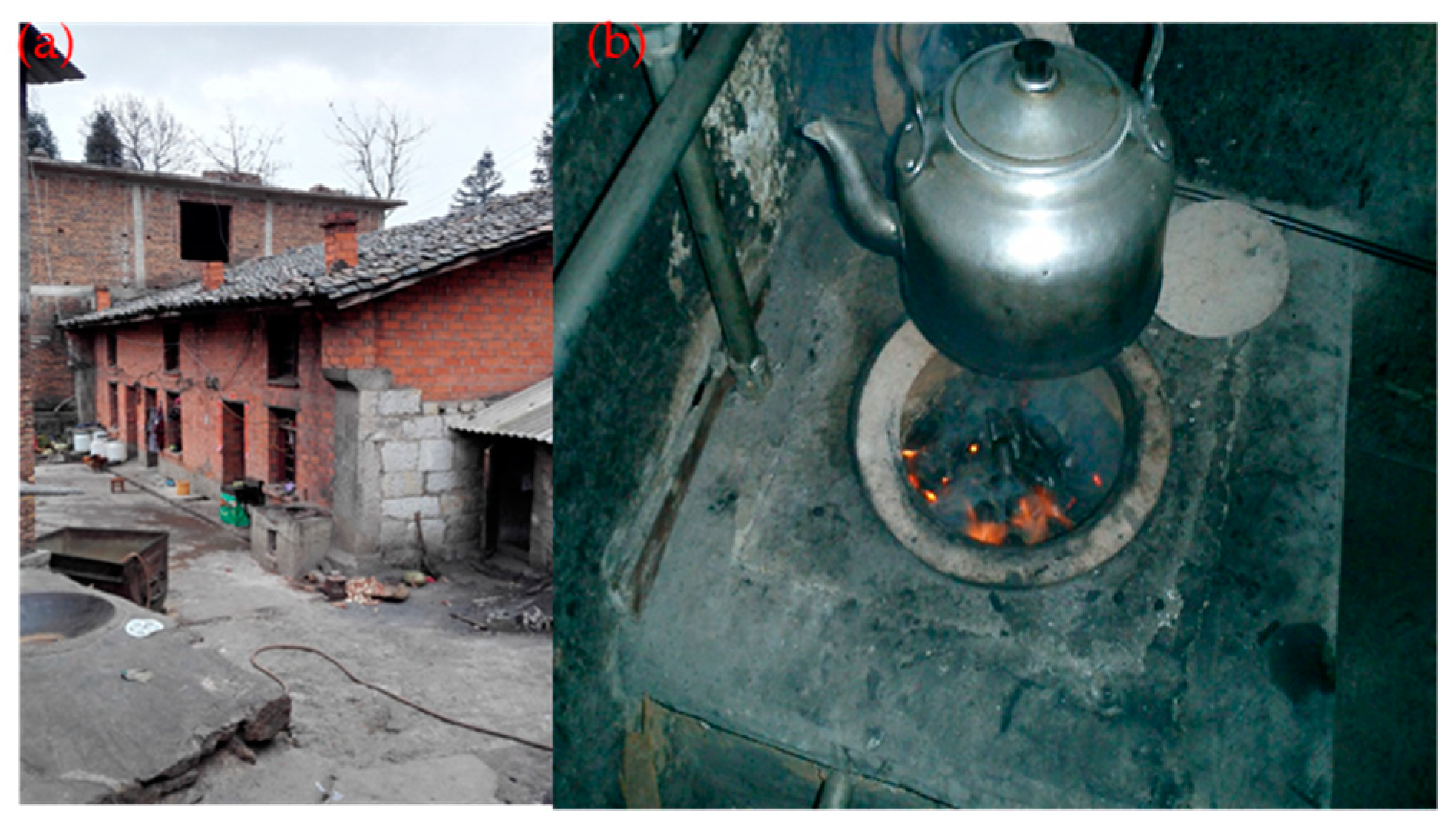
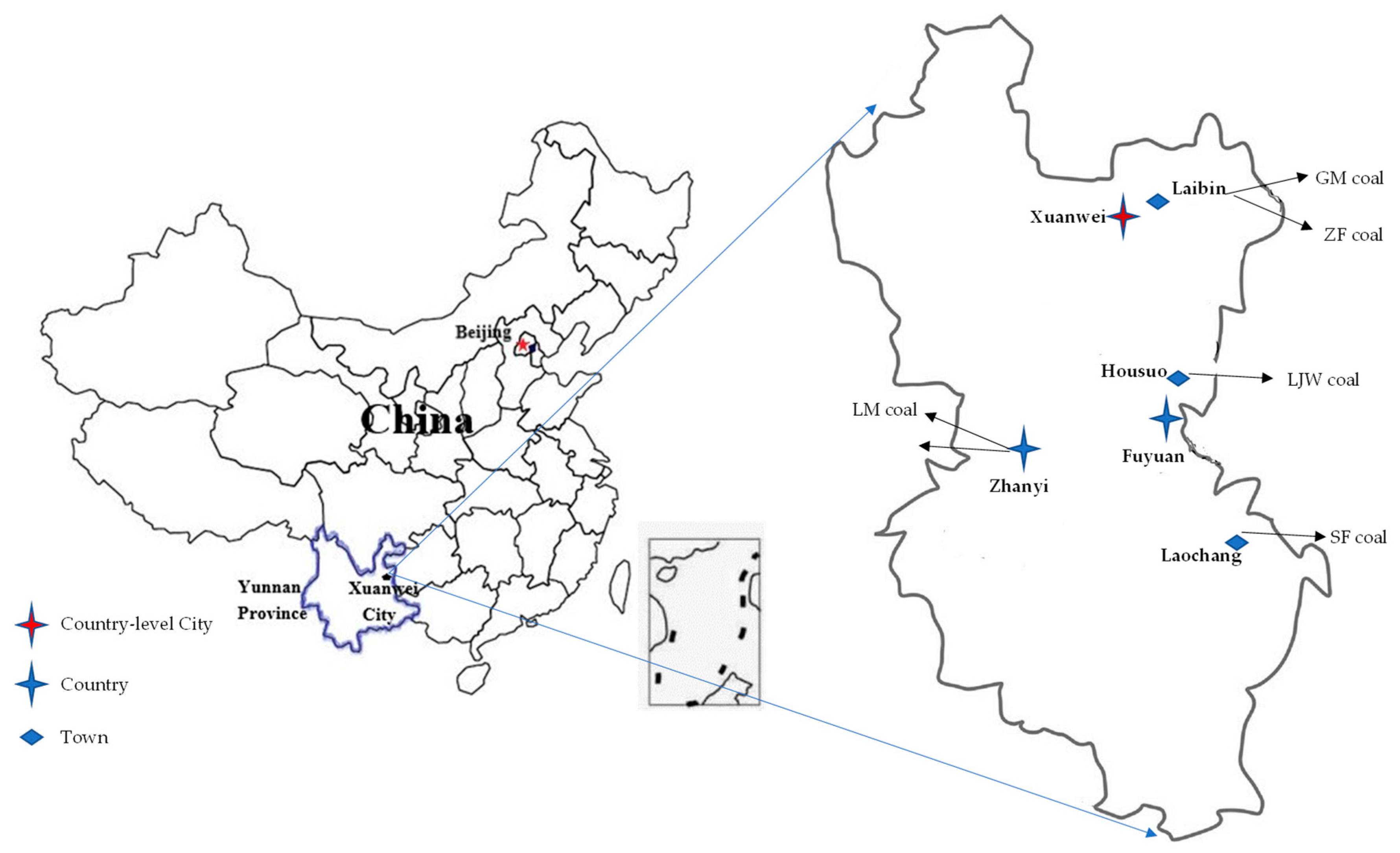

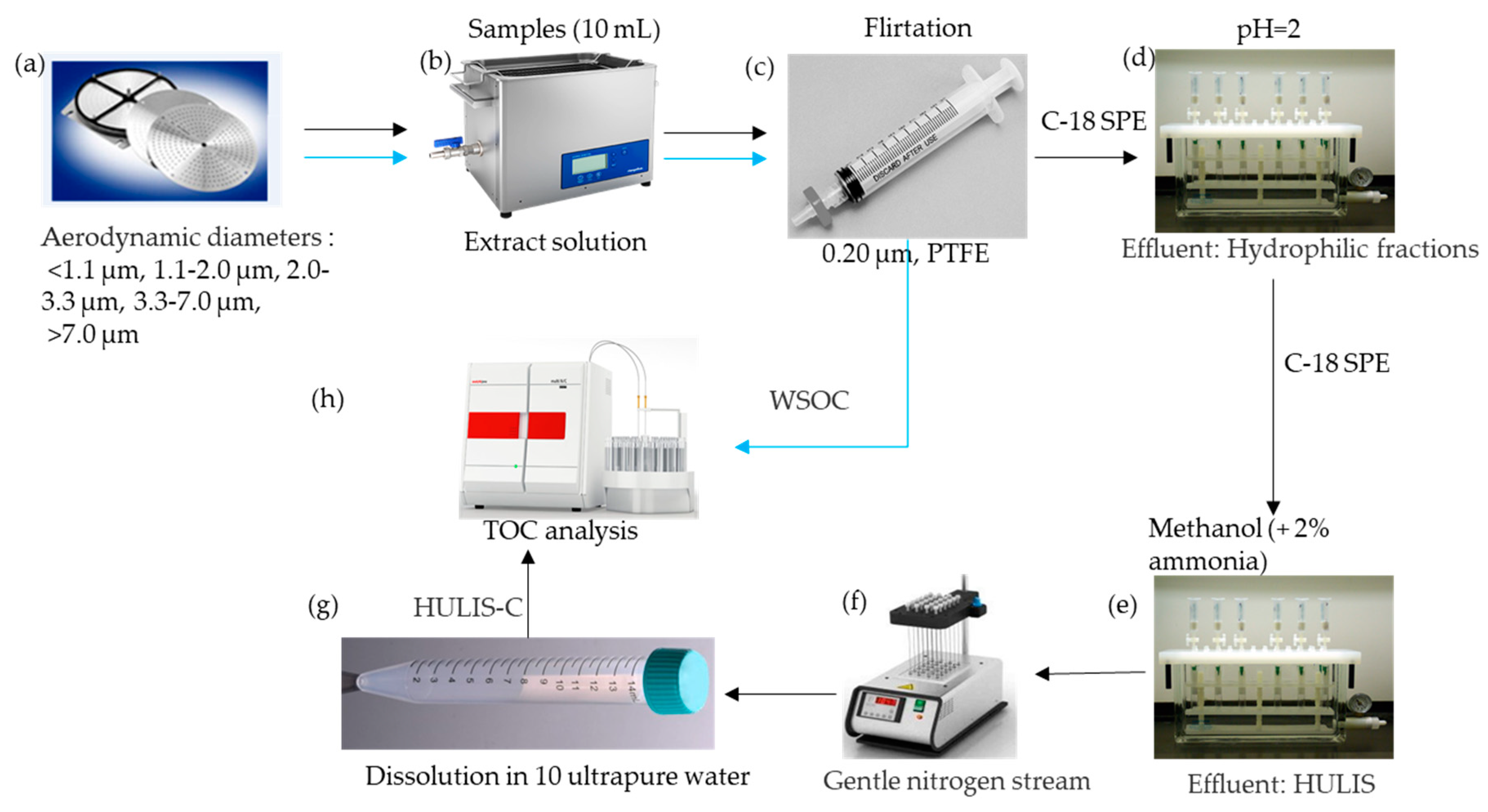
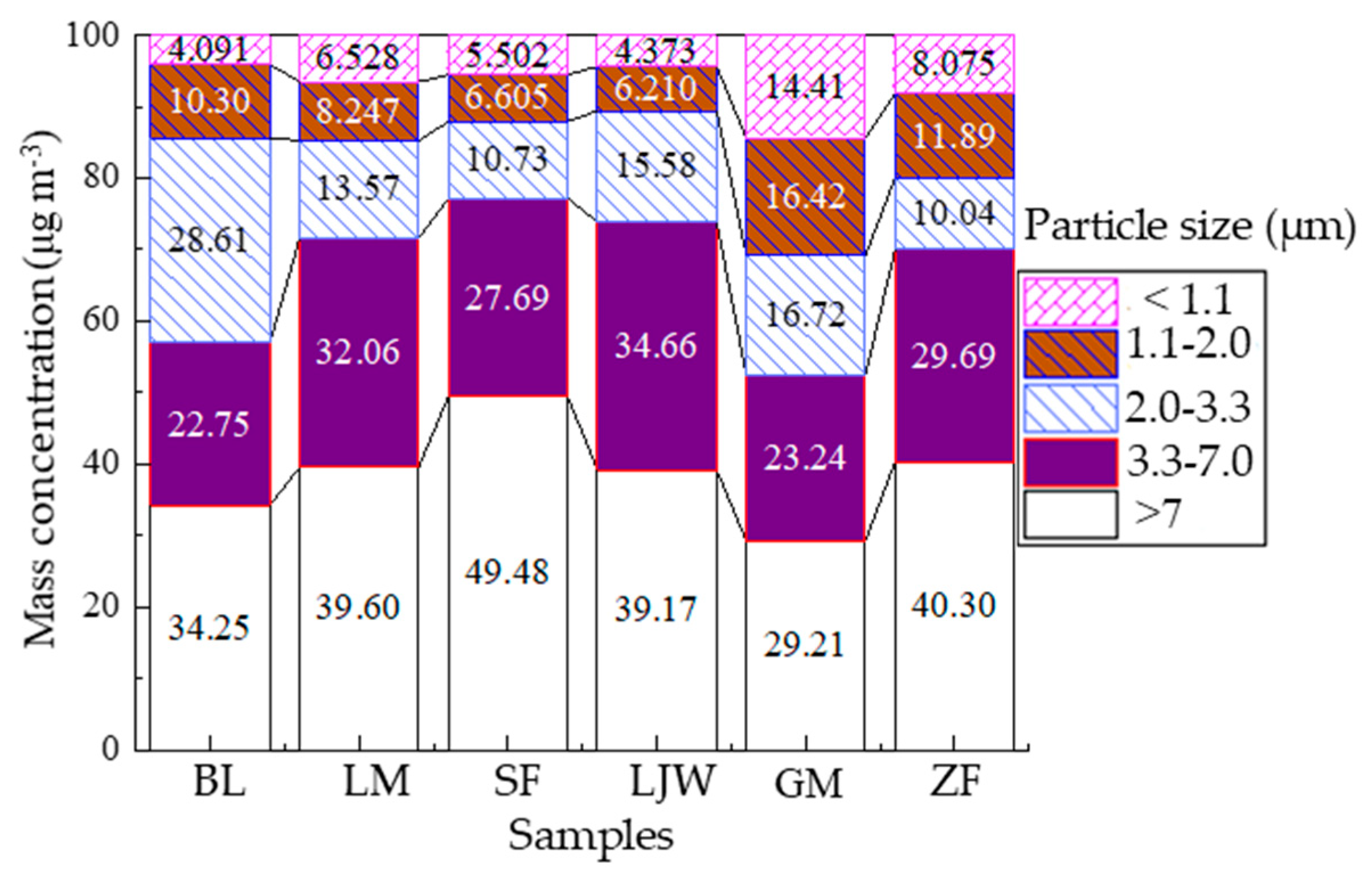
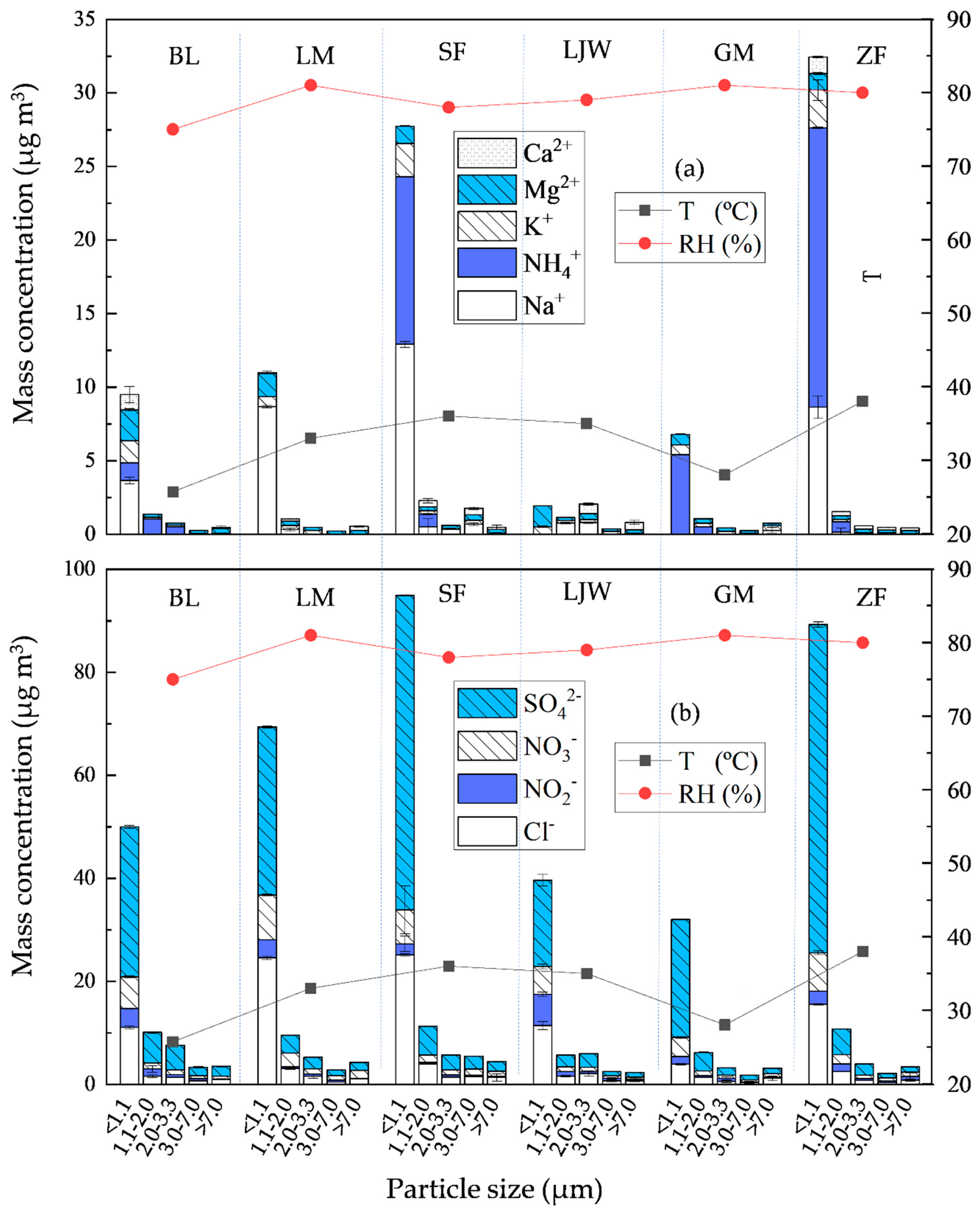
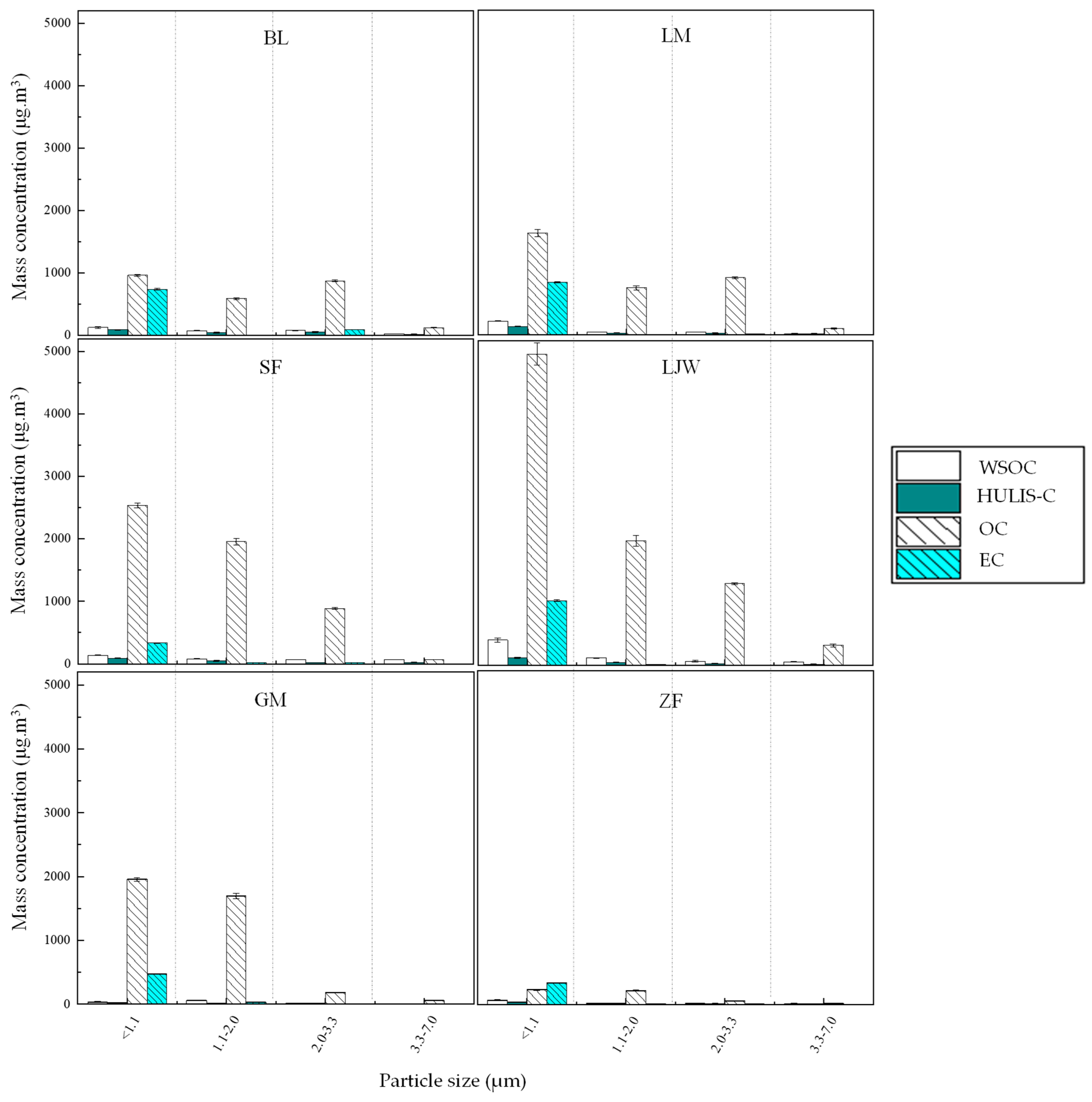
| Sites | Sample | Mine | Altitude/m | Latitude | Longitude |
|---|---|---|---|---|---|
| Zhanyi | BL | BL mine | 2104 | 25°47′15.32″ | 104°07′32.32″ |
| LM | LM mine | 1793 | 26°29′34.09″ | 103°46′9.17″ | |
| Fuyuan | SF | SF mine | 1994 | 25°13′31.13″ | 104°31′22.42″ |
| LJW | LJW mine | 2078 | 25°79′99.21″ | 104°28′60.06″ | |
| Xuanwei | GM | GM mine | 1987 | 26°19′46.55″ | 104°09′36.43″ |
| ZF | ZF mine | 2024 | 26°17′58.25″ | 104°05′42.49″ |
| Fration | Pyrolized Fration | Temperature Range (°C) | Atmosphere |
|---|---|---|---|
| OC1 | Ambient to 120 | 100% He | |
| OC2 | 120–150 | ||
| OC3 | 150–250 | ||
| OC4 | 250–450 | ||
| OPC | 450–550 | ||
| EC1 | OP | Remains at 550 | 98% He, 2% O2 |
| EC2 | 550–700 | ||
| EC3 | 700–800 |
| Exposure Parameter | Value for Children | Value for Adults |
|---|---|---|
| EF (exposure frequency) | 350 day·year−1 | 350 day·year−1 |
| ET (exposure time) | 24 h·day−1 | 24 h·day−1 |
| ED (exposure duration) | 6 years | 24 years |
| ATn (average time for non-carcinogenic) | ED × 365 days·year−1 × 24 h·day−1 | ED × 365 days·year−1 × 24 h·day−1 |
| ATc (average time for carcinogenic) | 74.83 year × 365 days·year−1 × 24 h·day−1 | 74.83 year × 365 days·year−1 × 24 h·day−1 |
| WSPTMs | IUR (μg m−3)−1 | RfC (mg m−3) |
|---|---|---|
| V | 8.3 × 10−3 | 1.0 × 10−4 |
| Cr (VI) | 1.2 × 10−2 | 1.0 × 10−4 |
| Co | 9.0 × 10−3 | 6.0 × 10−6 |
| Ni | 2.4 × 10−4 | 1.4 × 10−5 |
| As | 4.3 × 10−3 | 1.5 × 10−5 |
| Cd | 1.8 × 10−3 | 1.0 × 10−5 |
| Pb | 1.2 × 10−5 | - |
| Zn | - | 3.01 × 10−1 |
| Ba | - | 5.00 × 10−4 |
| Mn | - | 5.00 × 10−5 |
| Samples | Particle Size μm | OC | EC | TC | PM | HULIS-C | WSOC |
|---|---|---|---|---|---|---|---|
| μg m−3 | |||||||
| BL | PM2.0 | 1556.00 | 749.35 | 2305.35 | 3651.35 | 137.78 | 206.40 |
| LM | 2385.33 | 851.68 | 3237.01 | 7854.83 | 168.63 | 275.95 | |
| SF | 4490.54 | 353.95 | 4844.49 | 10,303.30 | 137.19 | 215.44 | |
| LJW | 6983.05 | 1056.47 | 8039.52 | 11,833.04 | 174.01 | 531.67 | |
| GM | 3649.02 | 503.15 | 4152.17 | 4185.81 | 38.76 | 90.00 | |
| ZF | 442.01 | 344.56 | 786.57 | 1810.95 | 49.52 | 88.85 | |
| Average | 3250.99 | 643.19 | 3894.18 | 6606.55 | 117.65 | 234.72 | |
| TSD | 2126.65 | 263.94 | 2264.47 | 3654.48 | 53.90 | 149.04 | |
| BL | PM2.0–7.0 | 1000.09 | 108.73 | 1108.82 | 2492.64 | 71.85 | 108.53 |
| LM | 1023.89 | 18.13 | 1042.02 | 2391.05 | 44.02 | 72.80 | |
| SF | 959.05 | 22.78 | 981.82 | 2314.49 | 45.92 | 135.41 | |
| LJW | 1632.95 | 16.60 | 1649.55 | 3492.34 | 46.40 | 131.92 | |
| GM | 244.74 | 6.04 | 250.78 | 1311.84 | 17.84 | 21.69 | |
| ZF | 76.47 | 8.35 | 84.82 | 1143.99 | 15.35 | 23.86 | |
| Average | 822.86 | 30.11 | 852.97 | 2191.06 | 40.23 | 82.37 | |
| TSD | 522.48 | 35.62 | 533.08 | 786.23 | 19.17 | 46.82 | |
| Samples | Size (μm) | HULIS-Cx/WSOCx | OCx PMx | ECx/PMx | WSOCx/TCx | HULIS-Cx/TCx | OCx/ECx | HULIS-Cx/PMx | WSOCx/PMx | HULISCx/HULIS-Ct |
|---|---|---|---|---|---|---|---|---|---|---|
| BL | PM2.0 | 66.76 | 42.61 | 20.52 | 8.95 | 5.98 | 2.08 | 3.77 | 5.65 | 65.73 |
| LM | 61.11 | 30.37 | 10.84 | 8.52 | 5.21 | 2.80 | 2.15 | 3.51 | 79.30 | |
| SF | 63.68 | 43.58 | 3.44 | 4.45 | 2.83 | 12.69 | 1.33 | 2.09 | 74.92 | |
| LJW | 32.73 | 59.01 | 8.93 | 6.61 | 2.16 | 6.61 | 1.47 | 4.49 | 78.95 | |
| GM | 43.07 | 87.18 | 12.02 | 2.17 | 0.93 | 7.25 | 0.93 | 2.15 | 68.48 | |
| ZF | 55.73 | 24.41 | 19.03 | 11.30 | 6.30 | 1.28 | 2.73 | 4.91 | 76.34 | |
| Average | 53.85 | 47.86 | 12.46 | 7.00 | 3.90 | 5.45 | 2.06 | 3.80 | 73.95 | |
| TSD | 12.12 | 20.70 | 5.84 | 3.02 | 2.03 | 3.93 | 0.96 | 1.35 | 5.13 | |
| BL | PM2.0–7.0 | 66.20 | 40.12 | 4.36 | 9.79 | 6.48 | 9.20 | 2.88 | 4.35 | 34.27 |
| LM | 60.47 | 42.82 | 0.76 | 6.99 | 4.22 | 56.46 | 1.84 | 3.04 | 20.70 | |
| SF | 33.91 | 41.44 | 0.98 | 13.79 | 4.68 | 42.11 | 1.98 | 5.85 | 25.08 | |
| LJW | 35.17 | 46.76 | 0.48 | 8.00 | 2.81 | 98.36 | 1.33 | 3.78 | 21.05 | |
| GM | 82.27 | 18.66 | 0.46 | 8.65 | 7.12 | 40.53 | 1.36 | 1.65 | 31.52 | |
| ZF | 64.35 | 6.68 | 0.73 | 28.13 | 18.10 | 9.16 | 1.34 | 2.09 | 23.66 | |
| Average | 57.06 | 32.75 | 1.30 | 12.56 | 7.23 | 42.64 | 1.79 | 3.46 | 26.05 | |
| TSD | 17.32 | 14.75 | 1.38 | 7.29 | 5.06 | 30.39 | 0.55 | 1.41 | 5.13 | |
| Samples | BL | LM | SF | LJW | GM | ZF | ||||||
|---|---|---|---|---|---|---|---|---|---|---|---|---|
| HUL IS-C | WS OC | HUL IS-C | WS OC | HUL IS-C | WS OC | HUL IS-C | WS OC | HUL IS-C | WS OC | HUL IS-C | WS OC | |
| Cl− | 0.66 ** | 0.71 *** | 0.42 * | 0.44 * | 0.06 ** | 0.14 *** | 0.76 ** | 0.80 * | −0.74 ** | −0.77 ** | 0.13 ** | 0.19 ** |
| NO2− | 0.06 ** | 0.14 *** | 0.15 * | 0.20 * | 0.94 ** | 0.99 *** | 0.63 ** | 0.72 * | −0.19 ** | −0.72 ** | −0.26 ** | −0.21 ** |
| NO3− | 0.84 ** | 0.83 *** | 1.00 * | 0.99 * | 0.94 ** | 0.99 *** | 0.95 ** | 0.99 * | 0.58 ** | 0.07 ** | 0.94 ** | 0.98 ** |
| SO42− | 0.74 ** | 0.72 *** | 0.97 * | 0.97 * | 0.81 ** | 0.85 *** | 0.95 ** | 0.99 * | 0.72 ** | 0.49 ** | 0.98 ** | 0.99 ** |
| Na+ | 0.89 ** | 0.80 *** | 0.99 * | 0.96 ** | 0.99 *** | −0.28 * | 0.73 ** | −0.29 ** | 0.97 ** | 0.99 * | ||
| NH4+ | 0.89 ** | 0.92 *** | 0.96 ** | 1.00 *** | 0.73 ** | 0.27 ** | 0.97 ** | 0.99 * | ||||
| K+ | 0.83 ** | 0.82 *** | 0.90 * | 0.89 * | 0.95 ** | 0.99 *** | 0.93 ** | 0.95 * | 0.69 ** | 0.30 ** | 0.97 ** | 0.99 ** |
| Mg2+ | 0.78 ** | 0.76 *** | 1.00 * | 0.99 * | 0.93 ** | 0.98 *** | 0.93 ** | 0.96 * | 0.80 ** | 0.38 ** | 0.98 ** | 0.99 ** |
| Ca2+ | 0.78 ** | 0.76 *** | −0.14 * | −0.09 * | −0.34 ** | −0.46 *** | −0.49 ** | −0.48 * | 0.29 ** | 0.90 ** | 0.98 ** | 0.99 ** |
Publisher’s Note: MDPI stays neutral with regard to jurisdictional claims in published maps and institutional affiliations. |
© 2021 by the authors. Licensee MDPI, Basel, Switzerland. This article is an open access article distributed under the terms and conditions of the Creative Commons Attribution (CC BY) license (https://creativecommons.org/licenses/by/4.0/).
Share and Cite
Xiao, K.; Wang, Q.; Lin, Y.; Wang, W.; Lu, S.; Yonemochi, S. Approval Research for Carcinogen Humic-Like Substances (HULIS) Emitted from Residential Coal Combustion in High Lung Cancer Incidence Areas of China. Processes 2021, 9, 1254. https://doi.org/10.3390/pr9071254
Xiao K, Wang Q, Lin Y, Wang W, Lu S, Yonemochi S. Approval Research for Carcinogen Humic-Like Substances (HULIS) Emitted from Residential Coal Combustion in High Lung Cancer Incidence Areas of China. Processes. 2021; 9(7):1254. https://doi.org/10.3390/pr9071254
Chicago/Turabian StyleXiao, Kai, Qingyue Wang, Yichun Lin, Weiqian Wang, Senlin Lu, and Shinich Yonemochi. 2021. "Approval Research for Carcinogen Humic-Like Substances (HULIS) Emitted from Residential Coal Combustion in High Lung Cancer Incidence Areas of China" Processes 9, no. 7: 1254. https://doi.org/10.3390/pr9071254
APA StyleXiao, K., Wang, Q., Lin, Y., Wang, W., Lu, S., & Yonemochi, S. (2021). Approval Research for Carcinogen Humic-Like Substances (HULIS) Emitted from Residential Coal Combustion in High Lung Cancer Incidence Areas of China. Processes, 9(7), 1254. https://doi.org/10.3390/pr9071254









